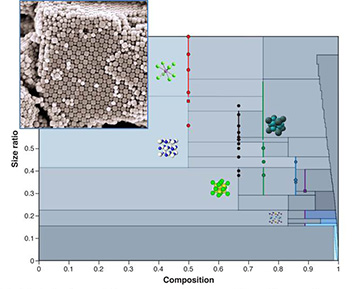A General Model Explains Binary Nanoparticle Assembly
February 13, 2017
What is the scientific achievement?
CFN scientists have created a general theoretical model that explains the observed wide diversity of periodic structures formed through nanoparticle self-assembly. The theory applies to a broad portfolio of experimental systems, across nanometer- and micron-length scales. The core interactions dictating the ultimate structure of the assembly are between two types of mutually attractive spherical particles.
Why does this achievement matter?
Nanoparticle assemblies allow design of new optical, electronic, and catalytic functions that naturally-forming materials do not have. This theoretical study introduces a universal framework for predicting the structure of assemblies as a function of the size and relative composition of the constituent nanoparticle building blocks.
What are the details?
 enlarge
enlarge
Calculated structures of binary nanoparticles assemblies. The resulting crystals are different, depending on the relative compositions of the two constituent particles, and the size ratio of the components. (Inset) Electron microscope image of an experimentally realized 3D binary crystal assembled from nanoparticles.
CFN Capabilities:
The CFN Theory and Computation Facility was used to model particle superlattices and to calculate 2D and 3D phase diagrams.
Publication Reference
A. Tkachenko, Proceedings of the National Academy of Sciences 113, 10269 (2016).
doi: 10.1073/pnas.1525358113
Acknowledgement of Support
This research was carried out at the Center for Functional Nanomaterials at Brookhaven National Laboratory (BNL), which is supported by the U.S. Department of Energy, Office of Basic Energy Sciences, under Contract no. DE-SC0012704.
2017-12213 | INT/EXT | Newsroom









